Building and Construction: Floor System Design & Compliance Analysis
VerifiedAdded on 2021/08/30
|14
|2244
|133
Practical Assignment
AI Summary
This assignment assesses the structural compliance of a timber floor system based on AS1684 standards. The student identifies non-compliant aspects of the provided floor grid, including missing footings, incorrect joist spans, and missing bearers. A detailed analysis highlights these deficiencies, followed by a proposed solution featuring a revised bearer and joist layout that adheres to AS1684. An alternative solution is proposed, utilizing laminated veneer lumber (LVL) for its strength and sustainability benefits. The assignment also covers the selection of galvanised steel stumps and particleboard flooring, detailing installation guidelines and considerations such as moisture content and expansion gaps. References to relevant standards and research papers are included to support the analysis and recommendations.
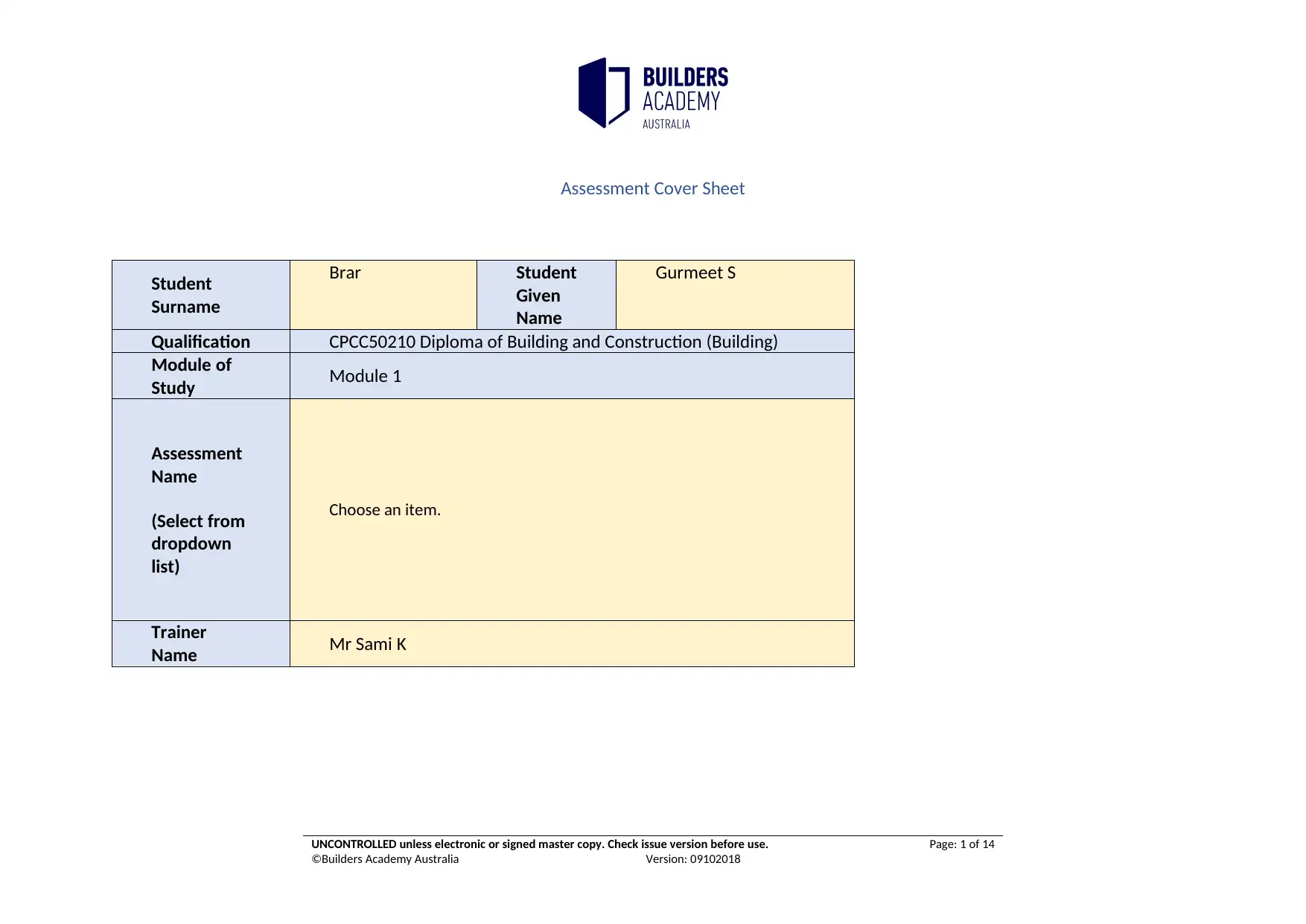
Assessment Cover Sheet
Student
Surname
Brar Student
Given
Name
Gurmeet S
Qualification CPCC50210 Diploma of Building and Construction (Building)
Module of
Study Module 1
Assessment
Name
(Select from
dropdown
list)
Choose an item.
Trainer
Name Mr Sami K
UNCONTROLLED unless electronic or signed master copy. Check issue version before use. Page: 1 of 14
©Builders Academy Australia Version: 09102018
Student
Surname
Brar Student
Given
Name
Gurmeet S
Qualification CPCC50210 Diploma of Building and Construction (Building)
Module of
Study Module 1
Assessment
Name
(Select from
dropdown
list)
Choose an item.
Trainer
Name Mr Sami K
UNCONTROLLED unless electronic or signed master copy. Check issue version before use. Page: 1 of 14
©Builders Academy Australia Version: 09102018
Paraphrase This Document
Need a fresh take? Get an instant paraphrase of this document with our AI Paraphraser
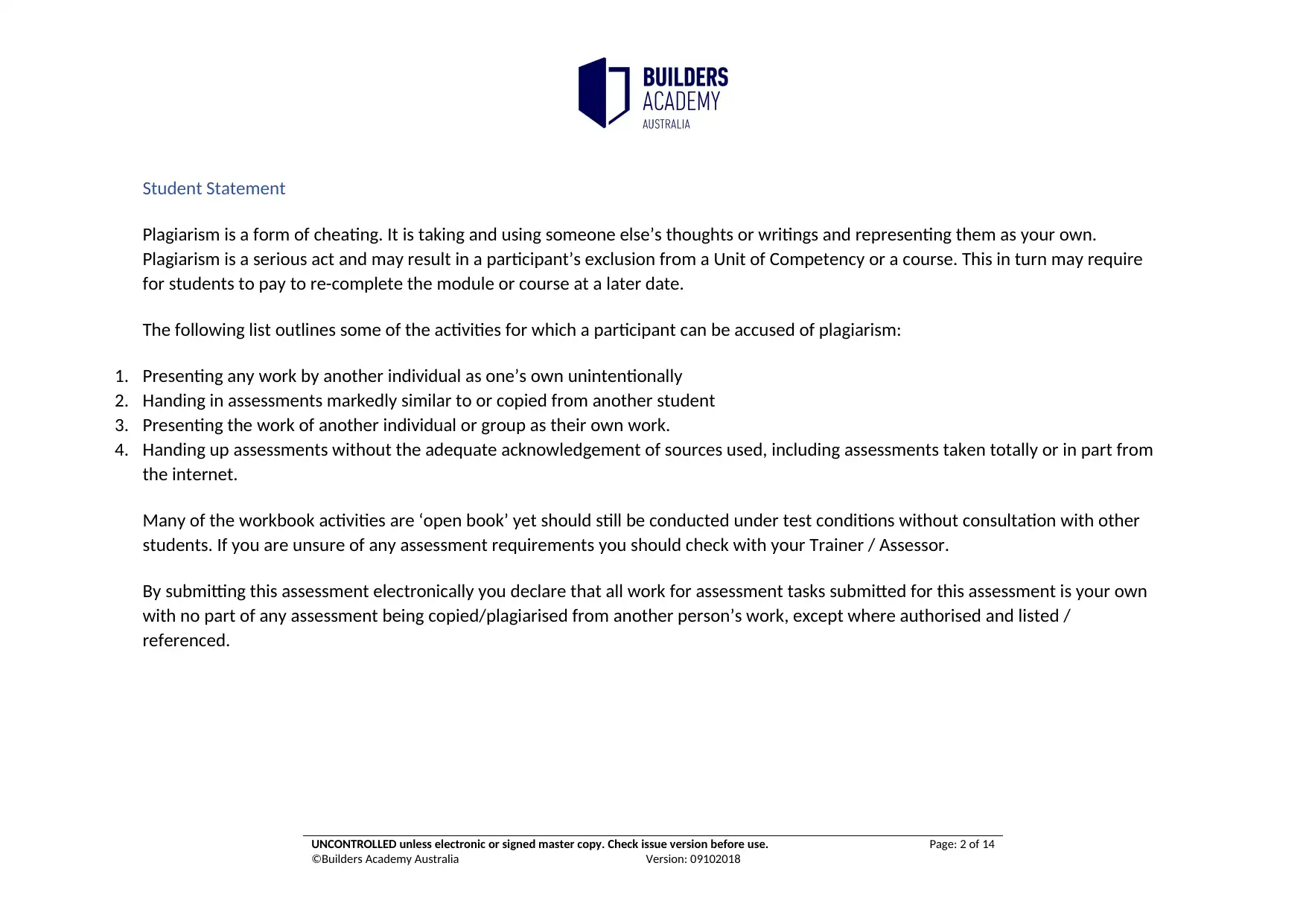
Student Statement
Plagiarism is a form of cheating. It is taking and using someone else’s thoughts or writings and representing them as your own.
Plagiarism is a serious act and may result in a participant’s exclusion from a Unit of Competency or a course. This in turn may require
for students to pay to re-complete the module or course at a later date.
The following list outlines some of the activities for which a participant can be accused of plagiarism:
1. Presenting any work by another individual as one’s own unintentionally
2. Handing in assessments markedly similar to or copied from another student
3. Presenting the work of another individual or group as their own work.
4. Handing up assessments without the adequate acknowledgement of sources used, including assessments taken totally or in part from
the internet.
Many of the workbook activities are ‘open book’ yet should still be conducted under test conditions without consultation with other
students. If you are unsure of any assessment requirements you should check with your Trainer / Assessor.
By submitting this assessment electronically you declare that all work for assessment tasks submitted for this assessment is your own
with no part of any assessment being copied/plagiarised from another person’s work, except where authorised and listed /
referenced.
UNCONTROLLED unless electronic or signed master copy. Check issue version before use. Page: 2 of 14
©Builders Academy Australia Version: 09102018
Plagiarism is a form of cheating. It is taking and using someone else’s thoughts or writings and representing them as your own.
Plagiarism is a serious act and may result in a participant’s exclusion from a Unit of Competency or a course. This in turn may require
for students to pay to re-complete the module or course at a later date.
The following list outlines some of the activities for which a participant can be accused of plagiarism:
1. Presenting any work by another individual as one’s own unintentionally
2. Handing in assessments markedly similar to or copied from another student
3. Presenting the work of another individual or group as their own work.
4. Handing up assessments without the adequate acknowledgement of sources used, including assessments taken totally or in part from
the internet.
Many of the workbook activities are ‘open book’ yet should still be conducted under test conditions without consultation with other
students. If you are unsure of any assessment requirements you should check with your Trainer / Assessor.
By submitting this assessment electronically you declare that all work for assessment tasks submitted for this assessment is your own
with no part of any assessment being copied/plagiarised from another person’s work, except where authorised and listed /
referenced.
UNCONTROLLED unless electronic or signed master copy. Check issue version before use. Page: 2 of 14
©Builders Academy Australia Version: 09102018
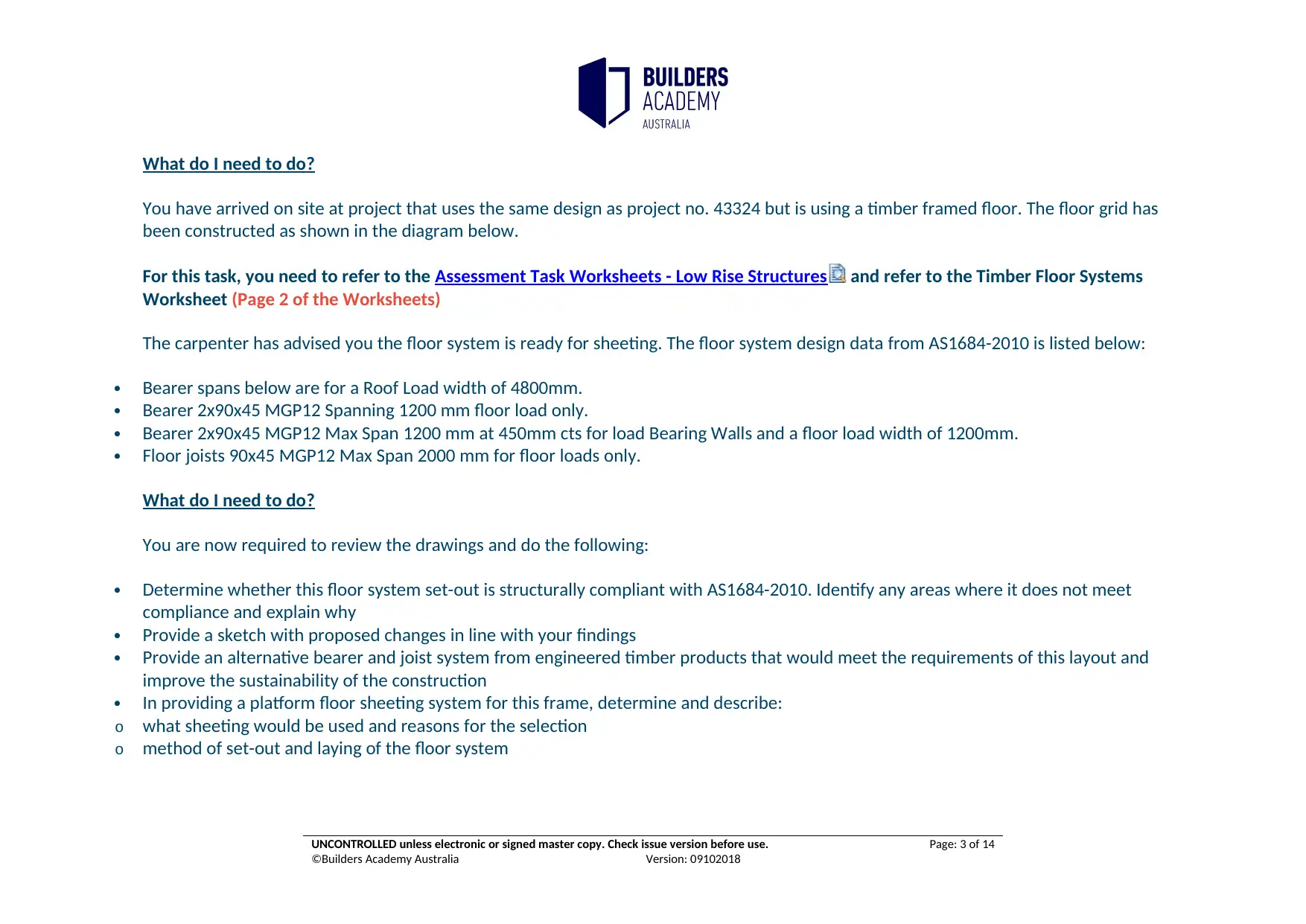
What do I need to do?
You have arrived on site at project that uses the same design as project no. 43324 but is using a timber framed floor. The floor grid has
been constructed as shown in the diagram below.
For this task, you need to refer to the Assessment Task Worksheets - Low Rise Structures and refer to the Timber Floor Systems
Worksheet (Page 2 of the Worksheets)
The carpenter has advised you the floor system is ready for sheeting. The floor system design data from AS1684-2010 is listed below:
Bearer spans below are for a Roof Load width of 4800mm.
Bearer 2x90x45 MGP12 Spanning 1200 mm floor load only.
Bearer 2x90x45 MGP12 Max Span 1200 mm at 450mm cts for load Bearing Walls and a floor load width of 1200mm.
Floor joists 90x45 MGP12 Max Span 2000 mm for floor loads only.
What do I need to do?
You are now required to review the drawings and do the following:
Determine whether this floor system set-out is structurally compliant with AS1684-2010. Identify any areas where it does not meet
compliance and explain why
Provide a sketch with proposed changes in line with your findings
Provide an alternative bearer and joist system from engineered timber products that would meet the requirements of this layout and
improve the sustainability of the construction
In providing a platform floor sheeting system for this frame, determine and describe:
o what sheeting would be used and reasons for the selection
o method of set-out and laying of the floor system
UNCONTROLLED unless electronic or signed master copy. Check issue version before use. Page: 3 of 14
©Builders Academy Australia Version: 09102018
You have arrived on site at project that uses the same design as project no. 43324 but is using a timber framed floor. The floor grid has
been constructed as shown in the diagram below.
For this task, you need to refer to the Assessment Task Worksheets - Low Rise Structures and refer to the Timber Floor Systems
Worksheet (Page 2 of the Worksheets)
The carpenter has advised you the floor system is ready for sheeting. The floor system design data from AS1684-2010 is listed below:
Bearer spans below are for a Roof Load width of 4800mm.
Bearer 2x90x45 MGP12 Spanning 1200 mm floor load only.
Bearer 2x90x45 MGP12 Max Span 1200 mm at 450mm cts for load Bearing Walls and a floor load width of 1200mm.
Floor joists 90x45 MGP12 Max Span 2000 mm for floor loads only.
What do I need to do?
You are now required to review the drawings and do the following:
Determine whether this floor system set-out is structurally compliant with AS1684-2010. Identify any areas where it does not meet
compliance and explain why
Provide a sketch with proposed changes in line with your findings
Provide an alternative bearer and joist system from engineered timber products that would meet the requirements of this layout and
improve the sustainability of the construction
In providing a platform floor sheeting system for this frame, determine and describe:
o what sheeting would be used and reasons for the selection
o method of set-out and laying of the floor system
UNCONTROLLED unless electronic or signed master copy. Check issue version before use. Page: 3 of 14
©Builders Academy Australia Version: 09102018
⊘ This is a preview!⊘
Do you want full access?
Subscribe today to unlock all pages.

Trusted by 1+ million students worldwide
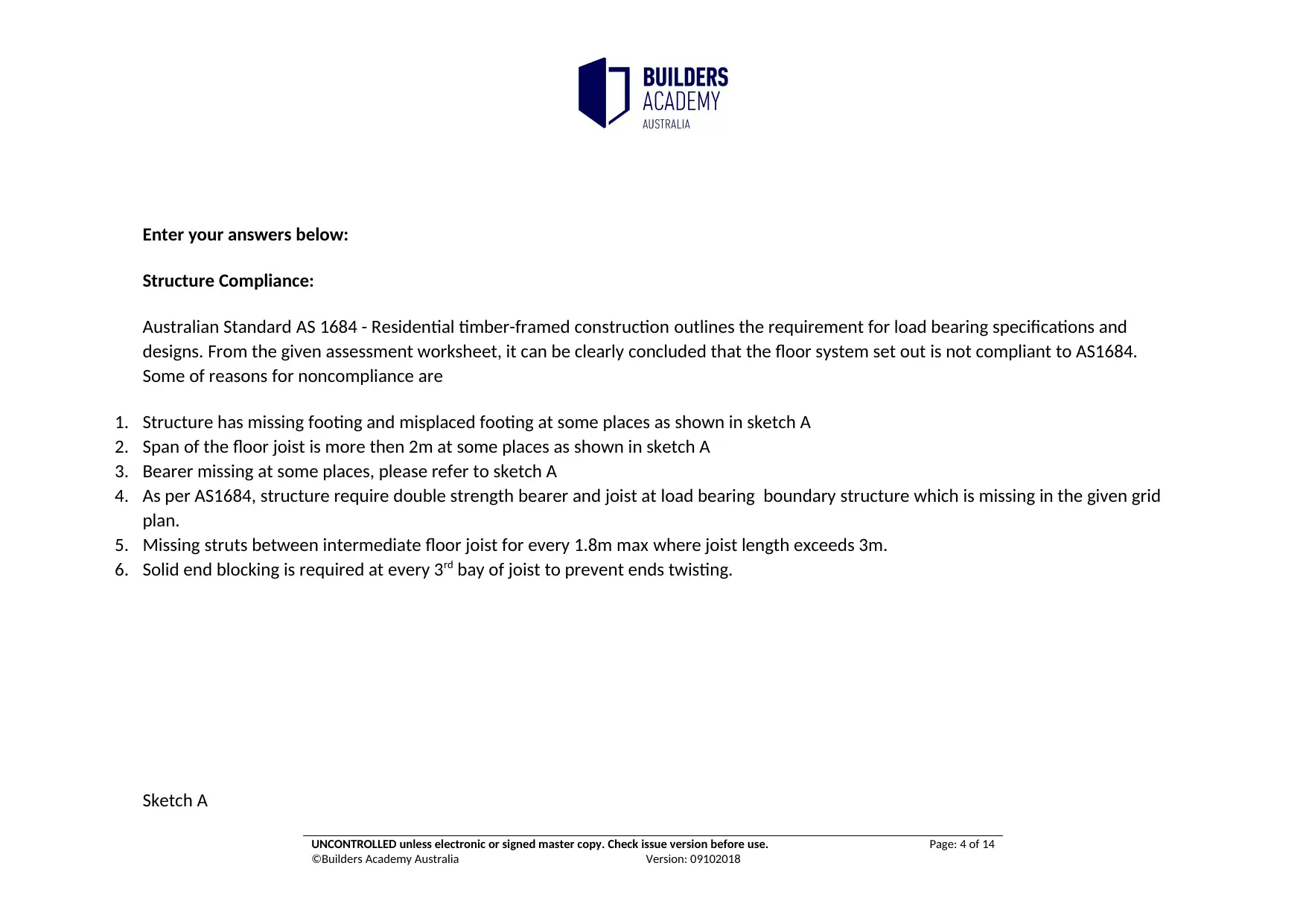
Enter your answers below:
Structure Compliance:
Australian Standard AS 1684 - Residential timber-framed construction outlines the requirement for load bearing specifications and
designs. From the given assessment worksheet, it can be clearly concluded that the floor system set out is not compliant to AS1684.
Some of reasons for noncompliance are
1. Structure has missing footing and misplaced footing at some places as shown in sketch A
2. Span of the floor joist is more then 2m at some places as shown in sketch A
3. Bearer missing at some places, please refer to sketch A
4. As per AS1684, structure require double strength bearer and joist at load bearing boundary structure which is missing in the given grid
plan.
5. Missing struts between intermediate floor joist for every 1.8m max where joist length exceeds 3m.
6. Solid end blocking is required at every 3rd bay of joist to prevent ends twisting.
Sketch A
UNCONTROLLED unless electronic or signed master copy. Check issue version before use. Page: 4 of 14
©Builders Academy Australia Version: 09102018
Structure Compliance:
Australian Standard AS 1684 - Residential timber-framed construction outlines the requirement for load bearing specifications and
designs. From the given assessment worksheet, it can be clearly concluded that the floor system set out is not compliant to AS1684.
Some of reasons for noncompliance are
1. Structure has missing footing and misplaced footing at some places as shown in sketch A
2. Span of the floor joist is more then 2m at some places as shown in sketch A
3. Bearer missing at some places, please refer to sketch A
4. As per AS1684, structure require double strength bearer and joist at load bearing boundary structure which is missing in the given grid
plan.
5. Missing struts between intermediate floor joist for every 1.8m max where joist length exceeds 3m.
6. Solid end blocking is required at every 3rd bay of joist to prevent ends twisting.
Sketch A
UNCONTROLLED unless electronic or signed master copy. Check issue version before use. Page: 4 of 14
©Builders Academy Australia Version: 09102018
Paraphrase This Document
Need a fresh take? Get an instant paraphrase of this document with our AI Paraphraser
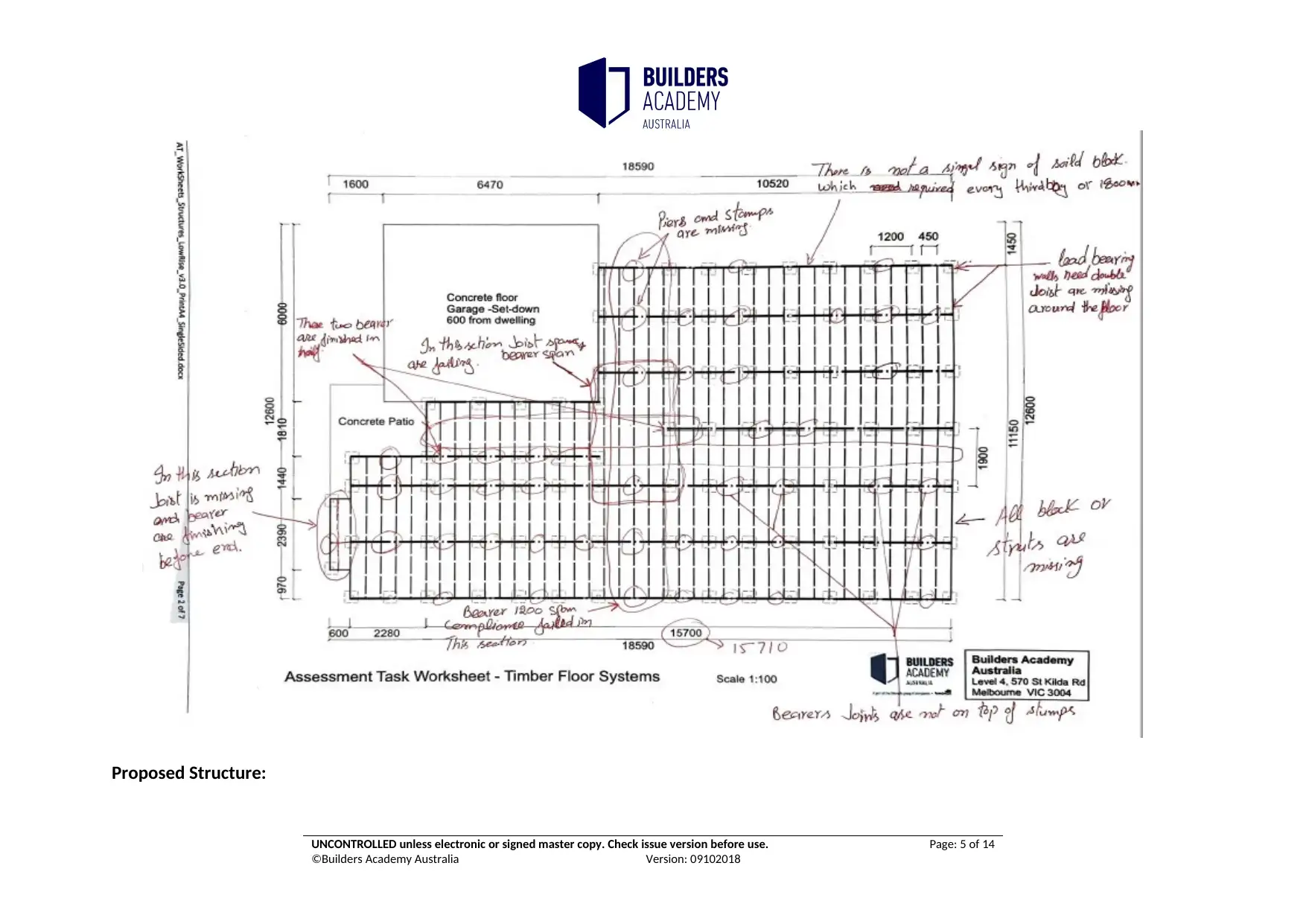
Proposed Structure:
UNCONTROLLED unless electronic or signed master copy. Check issue version before use. Page: 5 of 14
©Builders Academy Australia Version: 09102018
UNCONTROLLED unless electronic or signed master copy. Check issue version before use. Page: 5 of 14
©Builders Academy Australia Version: 09102018
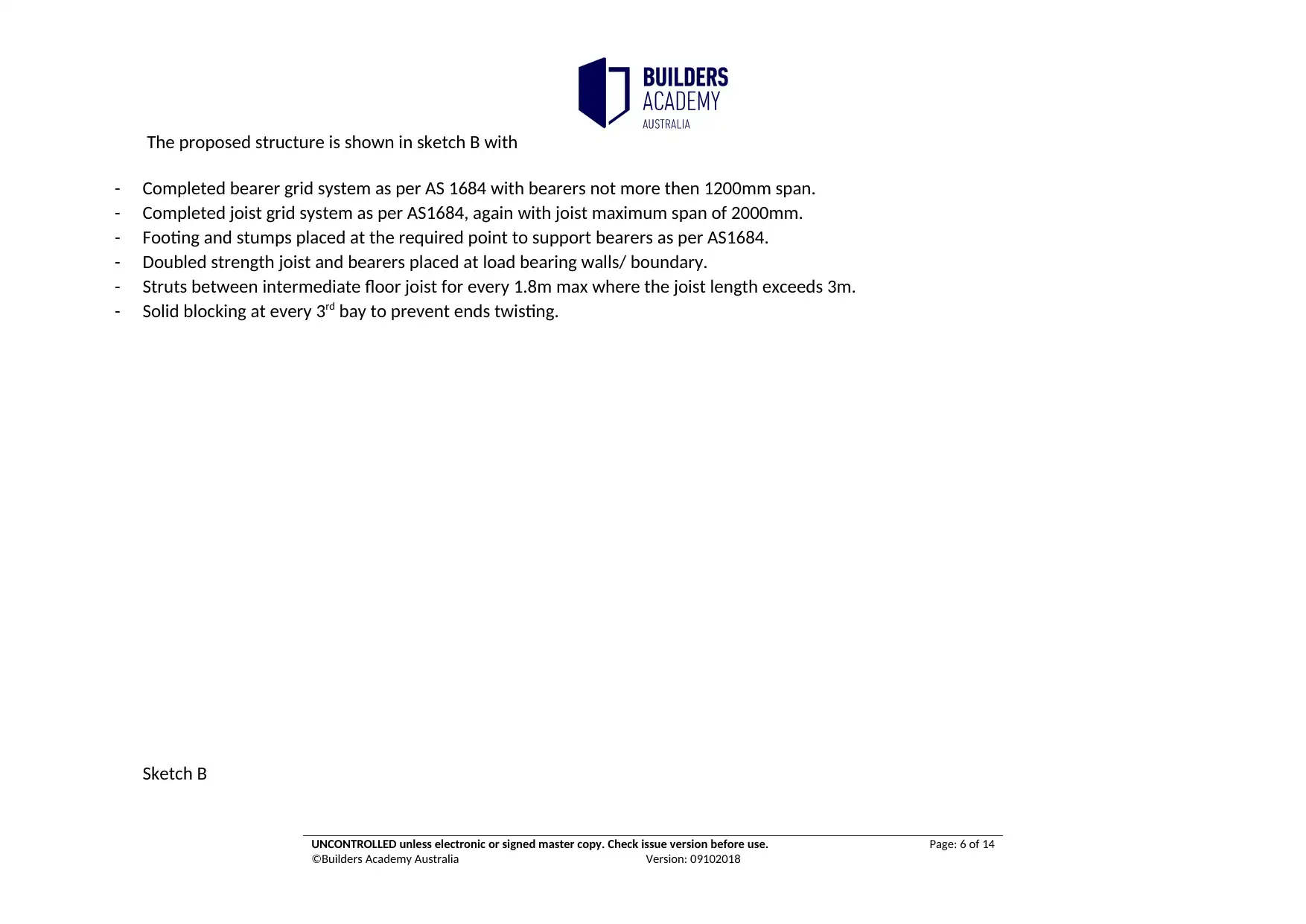
The proposed structure is shown in sketch B with
- Completed bearer grid system as per AS 1684 with bearers not more then 1200mm span.
- Completed joist grid system as per AS1684, again with joist maximum span of 2000mm.
- Footing and stumps placed at the required point to support bearers as per AS1684.
- Doubled strength joist and bearers placed at load bearing walls/ boundary.
- Struts between intermediate floor joist for every 1.8m max where the joist length exceeds 3m.
- Solid blocking at every 3rd bay to prevent ends twisting.
Sketch B
UNCONTROLLED unless electronic or signed master copy. Check issue version before use. Page: 6 of 14
©Builders Academy Australia Version: 09102018
- Completed bearer grid system as per AS 1684 with bearers not more then 1200mm span.
- Completed joist grid system as per AS1684, again with joist maximum span of 2000mm.
- Footing and stumps placed at the required point to support bearers as per AS1684.
- Doubled strength joist and bearers placed at load bearing walls/ boundary.
- Struts between intermediate floor joist for every 1.8m max where the joist length exceeds 3m.
- Solid blocking at every 3rd bay to prevent ends twisting.
Sketch B
UNCONTROLLED unless electronic or signed master copy. Check issue version before use. Page: 6 of 14
©Builders Academy Australia Version: 09102018
⊘ This is a preview!⊘
Do you want full access?
Subscribe today to unlock all pages.

Trusted by 1+ million students worldwide
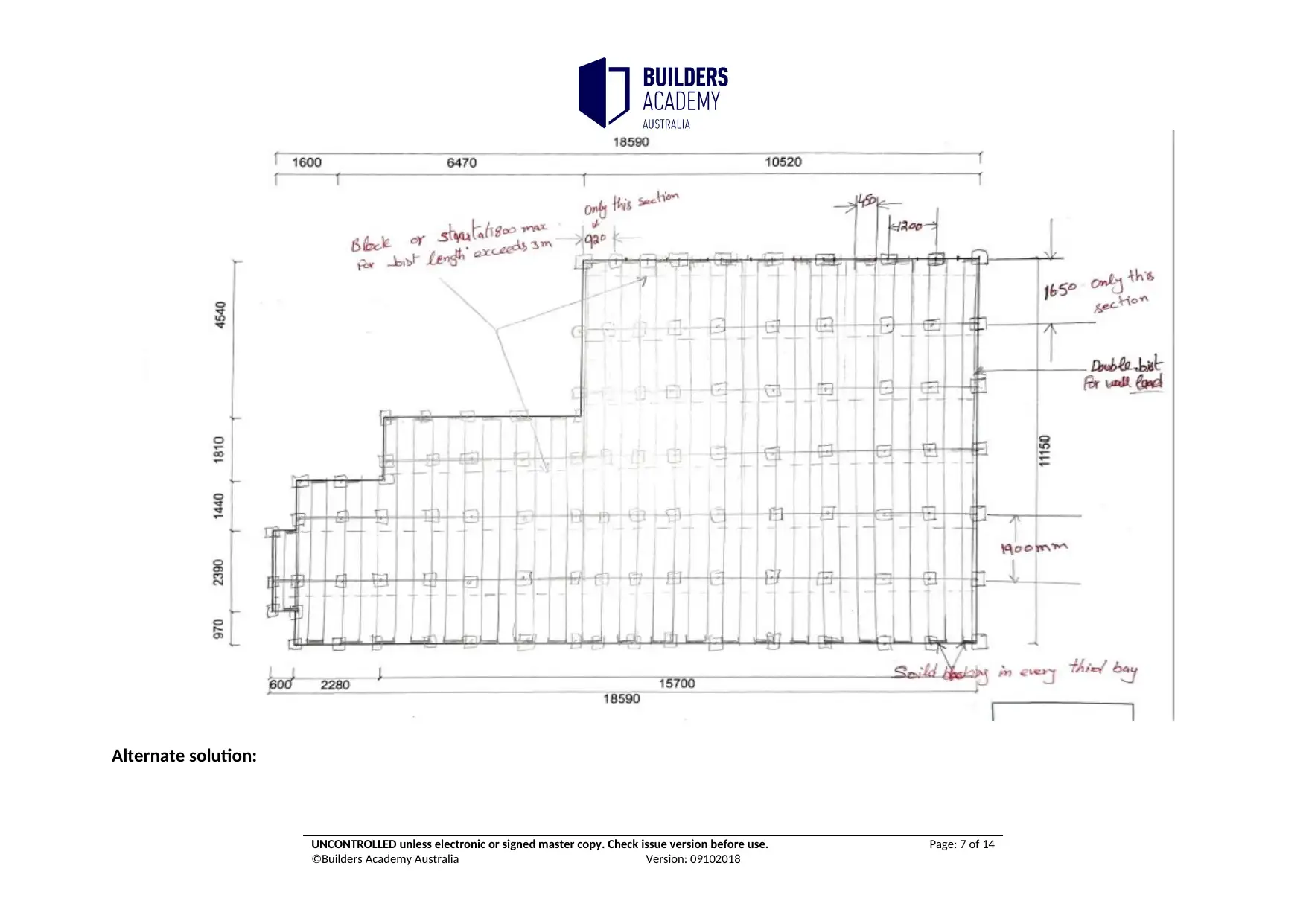
Alternate solution:
UNCONTROLLED unless electronic or signed master copy. Check issue version before use. Page: 7 of 14
©Builders Academy Australia Version: 09102018
UNCONTROLLED unless electronic or signed master copy. Check issue version before use. Page: 7 of 14
©Builders Academy Australia Version: 09102018
Paraphrase This Document
Need a fresh take? Get an instant paraphrase of this document with our AI Paraphraser
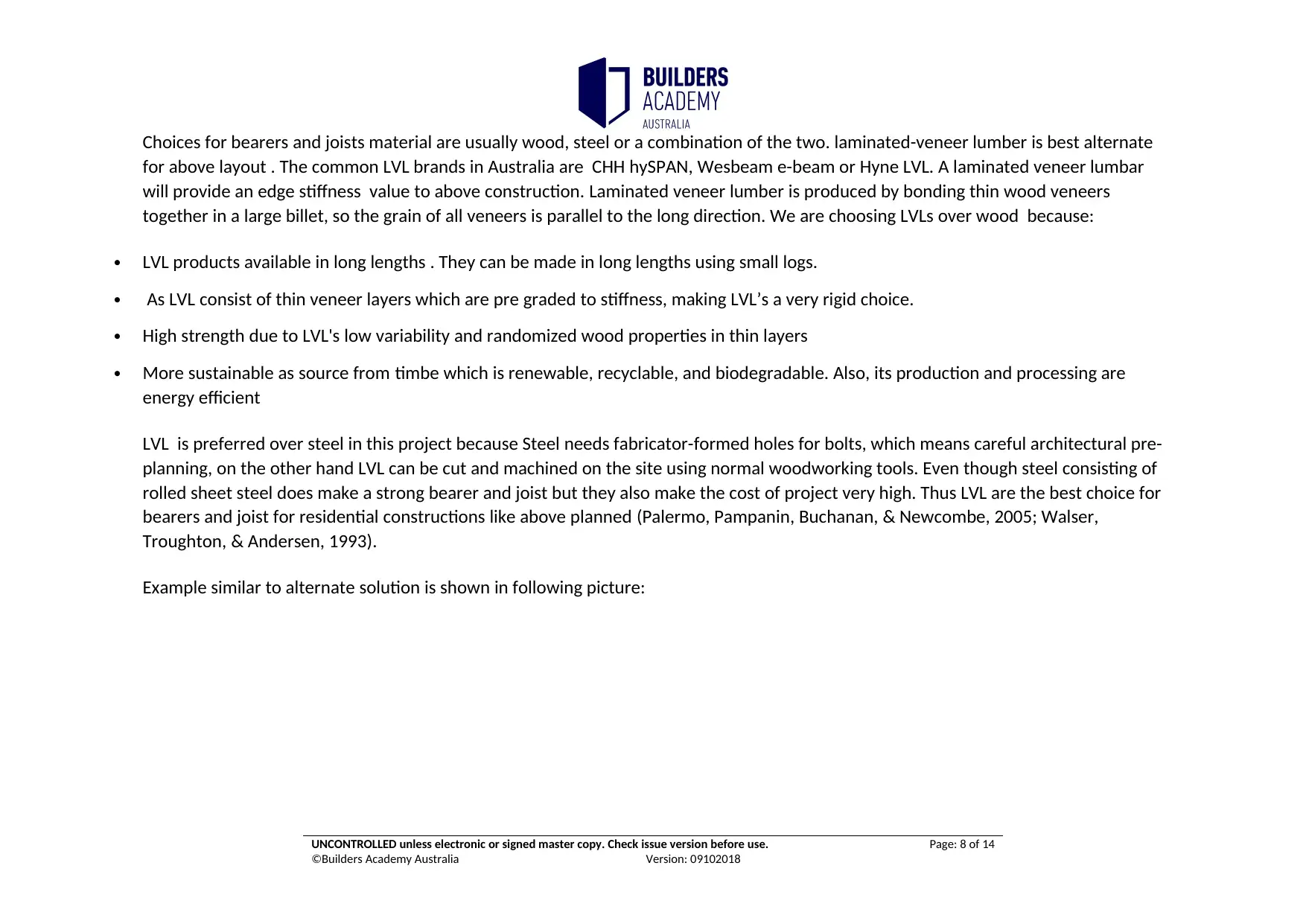
Choices for bearers and joists material are usually wood, steel or a combination of the two. laminated-veneer lumber is best alternate
for above layout . The common LVL brands in Australia are CHH hySPAN, Wesbeam e-beam or Hyne LVL. A laminated veneer lumbar
will provide an edge stiffness value to above construction. Laminated veneer lumber is produced by bonding thin wood veneers
together in a large billet, so the grain of all veneers is parallel to the long direction. We are choosing LVLs over wood because:
LVL products available in long lengths . They can be made in long lengths using small logs.
As LVL consist of thin veneer layers which are pre graded to stiffness, making LVL’s a very rigid choice.
High strength due to LVL's low variability and randomized wood properties in thin layers
More sustainable as source from timbe which is renewable, recyclable, and biodegradable. Also, its production and processing are
energy efficient
LVL is preferred over steel in this project because Steel needs fabricator-formed holes for bolts, which means careful architectural pre-
planning, on the other hand LVL can be cut and machined on the site using normal woodworking tools. Even though steel consisting of
rolled sheet steel does make a strong bearer and joist but they also make the cost of project very high. Thus LVL are the best choice for
bearers and joist for residential constructions like above planned (Palermo, Pampanin, Buchanan, & Newcombe, 2005; Walser,
Troughton, & Andersen, 1993).
Example similar to alternate solution is shown in following picture:
UNCONTROLLED unless electronic or signed master copy. Check issue version before use. Page: 8 of 14
©Builders Academy Australia Version: 09102018
for above layout . The common LVL brands in Australia are CHH hySPAN, Wesbeam e-beam or Hyne LVL. A laminated veneer lumbar
will provide an edge stiffness value to above construction. Laminated veneer lumber is produced by bonding thin wood veneers
together in a large billet, so the grain of all veneers is parallel to the long direction. We are choosing LVLs over wood because:
LVL products available in long lengths . They can be made in long lengths using small logs.
As LVL consist of thin veneer layers which are pre graded to stiffness, making LVL’s a very rigid choice.
High strength due to LVL's low variability and randomized wood properties in thin layers
More sustainable as source from timbe which is renewable, recyclable, and biodegradable. Also, its production and processing are
energy efficient
LVL is preferred over steel in this project because Steel needs fabricator-formed holes for bolts, which means careful architectural pre-
planning, on the other hand LVL can be cut and machined on the site using normal woodworking tools. Even though steel consisting of
rolled sheet steel does make a strong bearer and joist but they also make the cost of project very high. Thus LVL are the best choice for
bearers and joist for residential constructions like above planned (Palermo, Pampanin, Buchanan, & Newcombe, 2005; Walser,
Troughton, & Andersen, 1993).
Example similar to alternate solution is shown in following picture:
UNCONTROLLED unless electronic or signed master copy. Check issue version before use. Page: 8 of 14
©Builders Academy Australia Version: 09102018
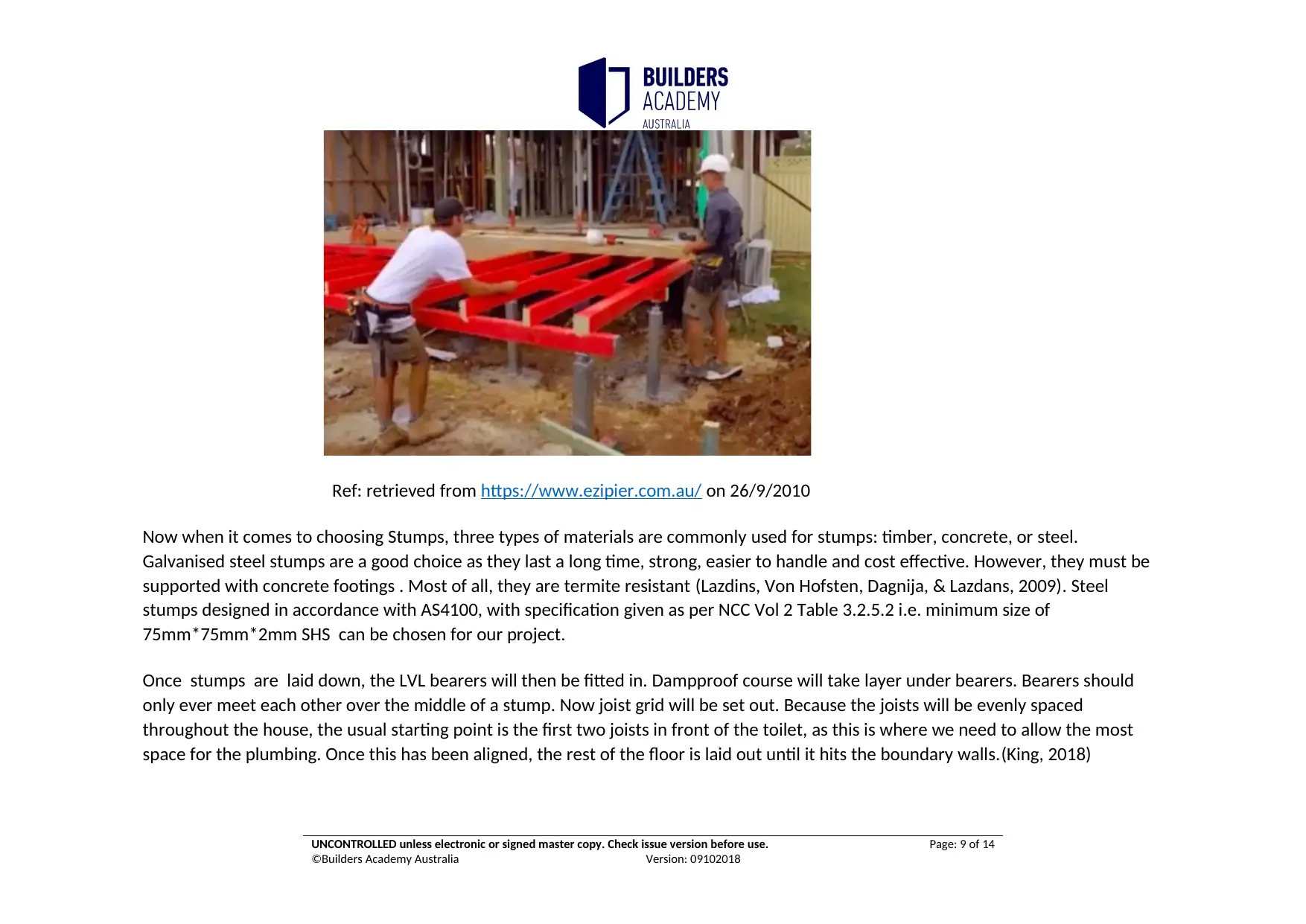
Ref: retrieved from https://www.ezipier.com.au/ on 26/9/2010
Now when it comes to choosing Stumps, three types of materials are commonly used for stumps: timber, concrete, or steel.
Galvanised steel stumps are a good choice as they last a long time, strong, easier to handle and cost effective. However, they must be
supported with concrete footings . Most of all, they are termite resistant (Lazdins, Von Hofsten, Dagnija, & Lazdans, 2009). Steel
stumps designed in accordance with AS4100, with specification given as per NCC Vol 2 Table 3.2.5.2 i.e. minimum size of
75mm*75mm*2mm SHS can be chosen for our project.
Once stumps are laid down, the LVL bearers will then be fitted in. Dampproof course will take layer under bearers. Bearers should
only ever meet each other over the middle of a stump. Now joist grid will be set out. Because the joists will be evenly spaced
throughout the house, the usual starting point is the first two joists in front of the toilet, as this is where we need to allow the most
space for the plumbing. Once this has been aligned, the rest of the floor is laid out until it hits the boundary walls.(King, 2018)
UNCONTROLLED unless electronic or signed master copy. Check issue version before use. Page: 9 of 14
©Builders Academy Australia Version: 09102018
Now when it comes to choosing Stumps, three types of materials are commonly used for stumps: timber, concrete, or steel.
Galvanised steel stumps are a good choice as they last a long time, strong, easier to handle and cost effective. However, they must be
supported with concrete footings . Most of all, they are termite resistant (Lazdins, Von Hofsten, Dagnija, & Lazdans, 2009). Steel
stumps designed in accordance with AS4100, with specification given as per NCC Vol 2 Table 3.2.5.2 i.e. minimum size of
75mm*75mm*2mm SHS can be chosen for our project.
Once stumps are laid down, the LVL bearers will then be fitted in. Dampproof course will take layer under bearers. Bearers should
only ever meet each other over the middle of a stump. Now joist grid will be set out. Because the joists will be evenly spaced
throughout the house, the usual starting point is the first two joists in front of the toilet, as this is where we need to allow the most
space for the plumbing. Once this has been aligned, the rest of the floor is laid out until it hits the boundary walls.(King, 2018)
UNCONTROLLED unless electronic or signed master copy. Check issue version before use. Page: 9 of 14
©Builders Academy Australia Version: 09102018
⊘ This is a preview!⊘
Do you want full access?
Subscribe today to unlock all pages.

Trusted by 1+ million students worldwide
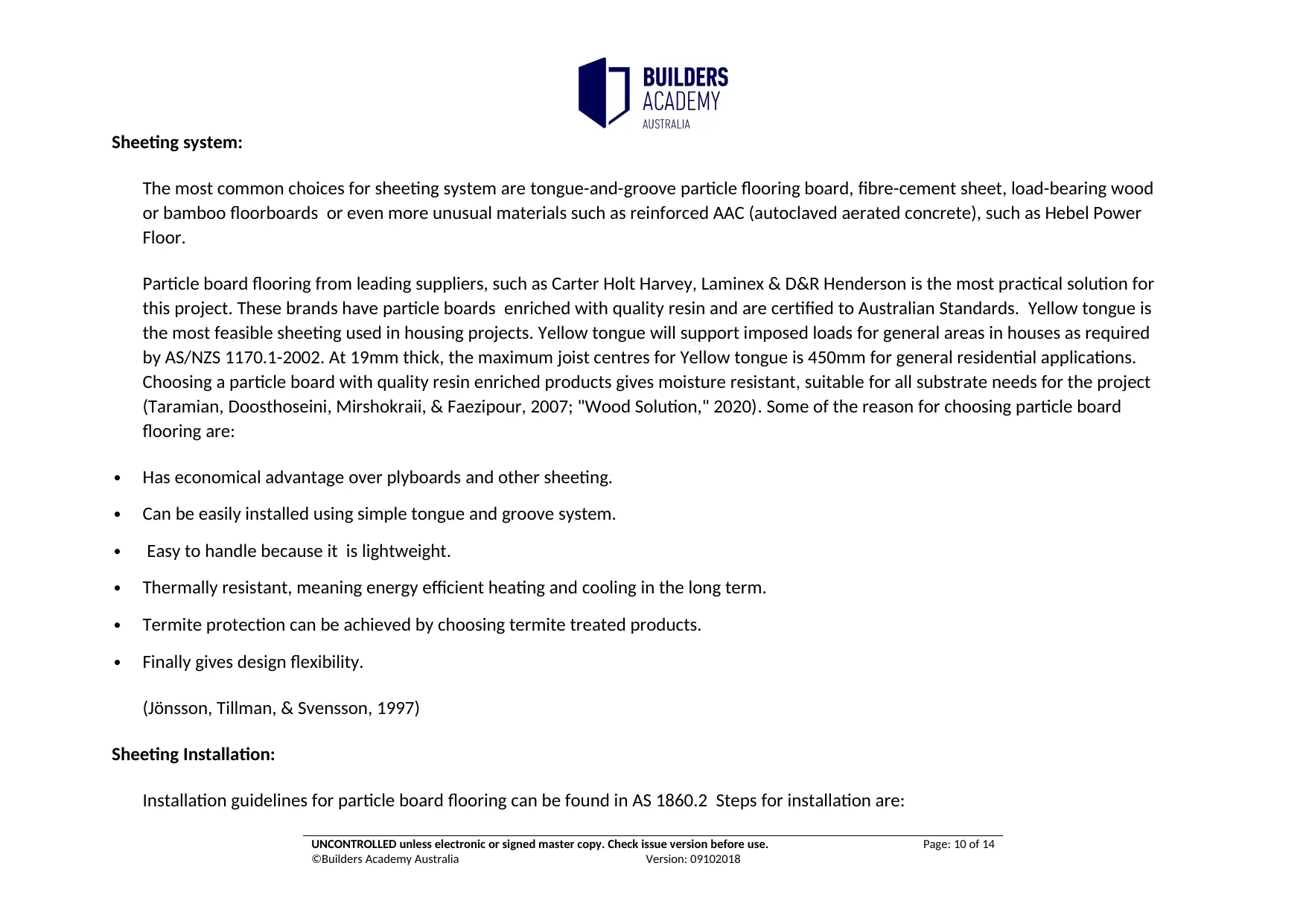
Sheeting system:
The most common choices for sheeting system are tongue-and-groove particle flooring board, fibre-cement sheet, load-bearing wood
or bamboo floorboards or even more unusual materials such as reinforced AAC (autoclaved aerated concrete), such as Hebel Power
Floor.
Particle board flooring from leading suppliers, such as Carter Holt Harvey, Laminex & D&R Henderson is the most practical solution for
this project. These brands have particle boards enriched with quality resin and are certified to Australian Standards. Yellow tongue is
the most feasible sheeting used in housing projects. Yellow tongue will support imposed loads for general areas in houses as required
by AS/NZS 1170.1-2002. At 19mm thick, the maximum joist centres for Yellow tongue is 450mm for general residential applications.
Choosing a particle board with quality resin enriched products gives moisture resistant, suitable for all substrate needs for the project
(Taramian, Doosthoseini, Mirshokraii, & Faezipour, 2007; "Wood Solution," 2020). Some of the reason for choosing particle board
flooring are:
Has economical advantage over plyboards and other sheeting.
Can be easily installed using simple tongue and groove system.
Easy to handle because it is lightweight.
Thermally resistant, meaning energy efficient heating and cooling in the long term.
Termite protection can be achieved by choosing termite treated products.
Finally gives design flexibility.
(Jönsson, Tillman, & Svensson, 1997)
Sheeting Installation:
Installation guidelines for particle board flooring can be found in AS 1860.2 Steps for installation are:
UNCONTROLLED unless electronic or signed master copy. Check issue version before use. Page: 10 of 14
©Builders Academy Australia Version: 09102018
The most common choices for sheeting system are tongue-and-groove particle flooring board, fibre-cement sheet, load-bearing wood
or bamboo floorboards or even more unusual materials such as reinforced AAC (autoclaved aerated concrete), such as Hebel Power
Floor.
Particle board flooring from leading suppliers, such as Carter Holt Harvey, Laminex & D&R Henderson is the most practical solution for
this project. These brands have particle boards enriched with quality resin and are certified to Australian Standards. Yellow tongue is
the most feasible sheeting used in housing projects. Yellow tongue will support imposed loads for general areas in houses as required
by AS/NZS 1170.1-2002. At 19mm thick, the maximum joist centres for Yellow tongue is 450mm for general residential applications.
Choosing a particle board with quality resin enriched products gives moisture resistant, suitable for all substrate needs for the project
(Taramian, Doosthoseini, Mirshokraii, & Faezipour, 2007; "Wood Solution," 2020). Some of the reason for choosing particle board
flooring are:
Has economical advantage over plyboards and other sheeting.
Can be easily installed using simple tongue and groove system.
Easy to handle because it is lightweight.
Thermally resistant, meaning energy efficient heating and cooling in the long term.
Termite protection can be achieved by choosing termite treated products.
Finally gives design flexibility.
(Jönsson, Tillman, & Svensson, 1997)
Sheeting Installation:
Installation guidelines for particle board flooring can be found in AS 1860.2 Steps for installation are:
UNCONTROLLED unless electronic or signed master copy. Check issue version before use. Page: 10 of 14
©Builders Academy Australia Version: 09102018
Paraphrase This Document
Need a fresh take? Get an instant paraphrase of this document with our AI Paraphraser
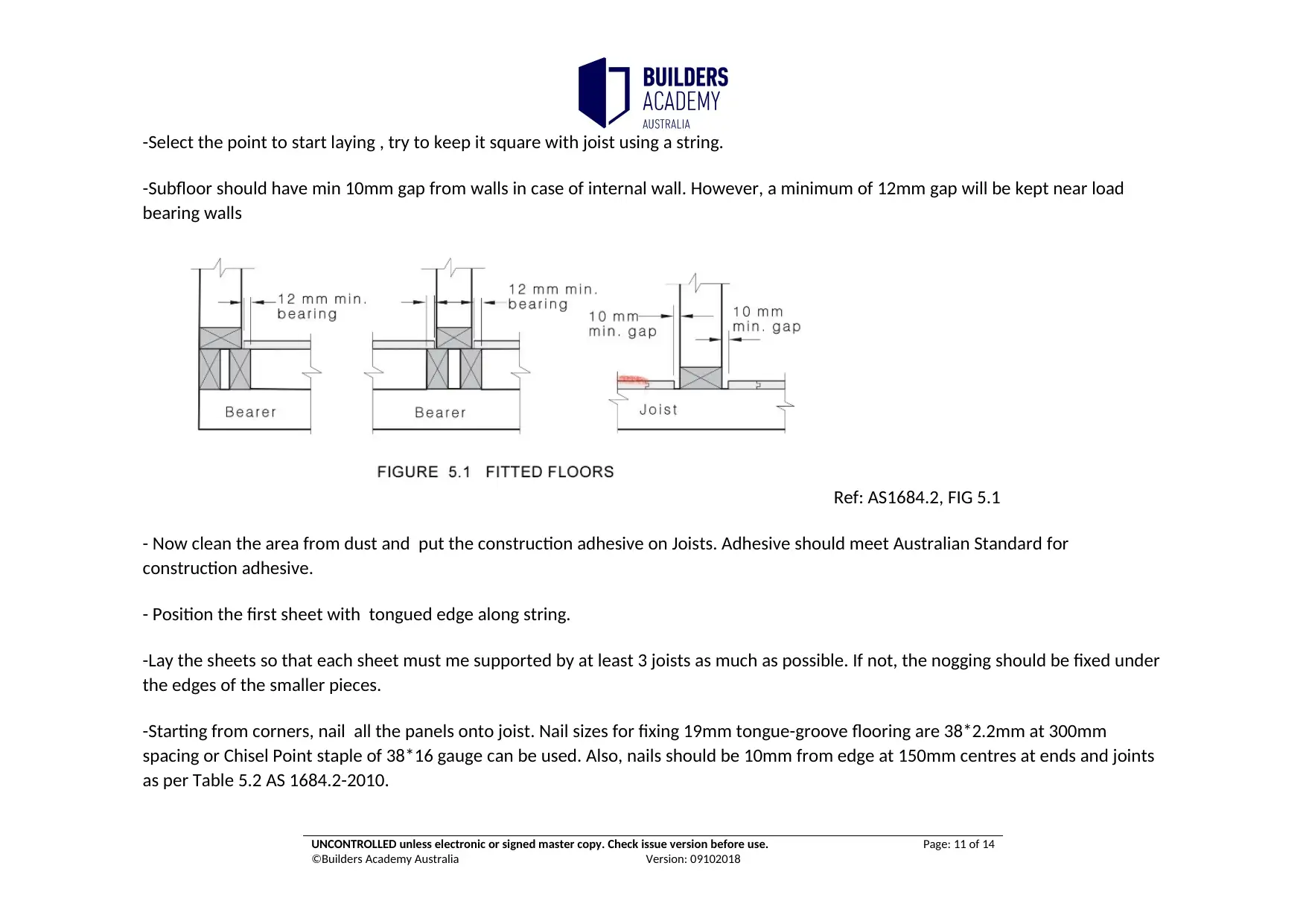
-Select the point to start laying , try to keep it square with joist using a string.
-Subfloor should have min 10mm gap from walls in case of internal wall. However, a minimum of 12mm gap will be kept near load
bearing walls
Ref: AS1684.2, FIG 5.1
- Now clean the area from dust and put the construction adhesive on Joists. Adhesive should meet Australian Standard for
construction adhesive.
- Position the first sheet with tongued edge along string.
-Lay the sheets so that each sheet must me supported by at least 3 joists as much as possible. If not, the nogging should be fixed under
the edges of the smaller pieces.
-Starting from corners, nail all the panels onto joist. Nail sizes for fixing 19mm tongue-groove flooring are 38*2.2mm at 300mm
spacing or Chisel Point staple of 38*16 gauge can be used. Also, nails should be 10mm from edge at 150mm centres at ends and joints
as per Table 5.2 AS 1684.2-2010.
UNCONTROLLED unless electronic or signed master copy. Check issue version before use. Page: 11 of 14
©Builders Academy Australia Version: 09102018
-Subfloor should have min 10mm gap from walls in case of internal wall. However, a minimum of 12mm gap will be kept near load
bearing walls
Ref: AS1684.2, FIG 5.1
- Now clean the area from dust and put the construction adhesive on Joists. Adhesive should meet Australian Standard for
construction adhesive.
- Position the first sheet with tongued edge along string.
-Lay the sheets so that each sheet must me supported by at least 3 joists as much as possible. If not, the nogging should be fixed under
the edges of the smaller pieces.
-Starting from corners, nail all the panels onto joist. Nail sizes for fixing 19mm tongue-groove flooring are 38*2.2mm at 300mm
spacing or Chisel Point staple of 38*16 gauge can be used. Also, nails should be 10mm from edge at 150mm centres at ends and joints
as per Table 5.2 AS 1684.2-2010.
UNCONTROLLED unless electronic or signed master copy. Check issue version before use. Page: 11 of 14
©Builders Academy Australia Version: 09102018
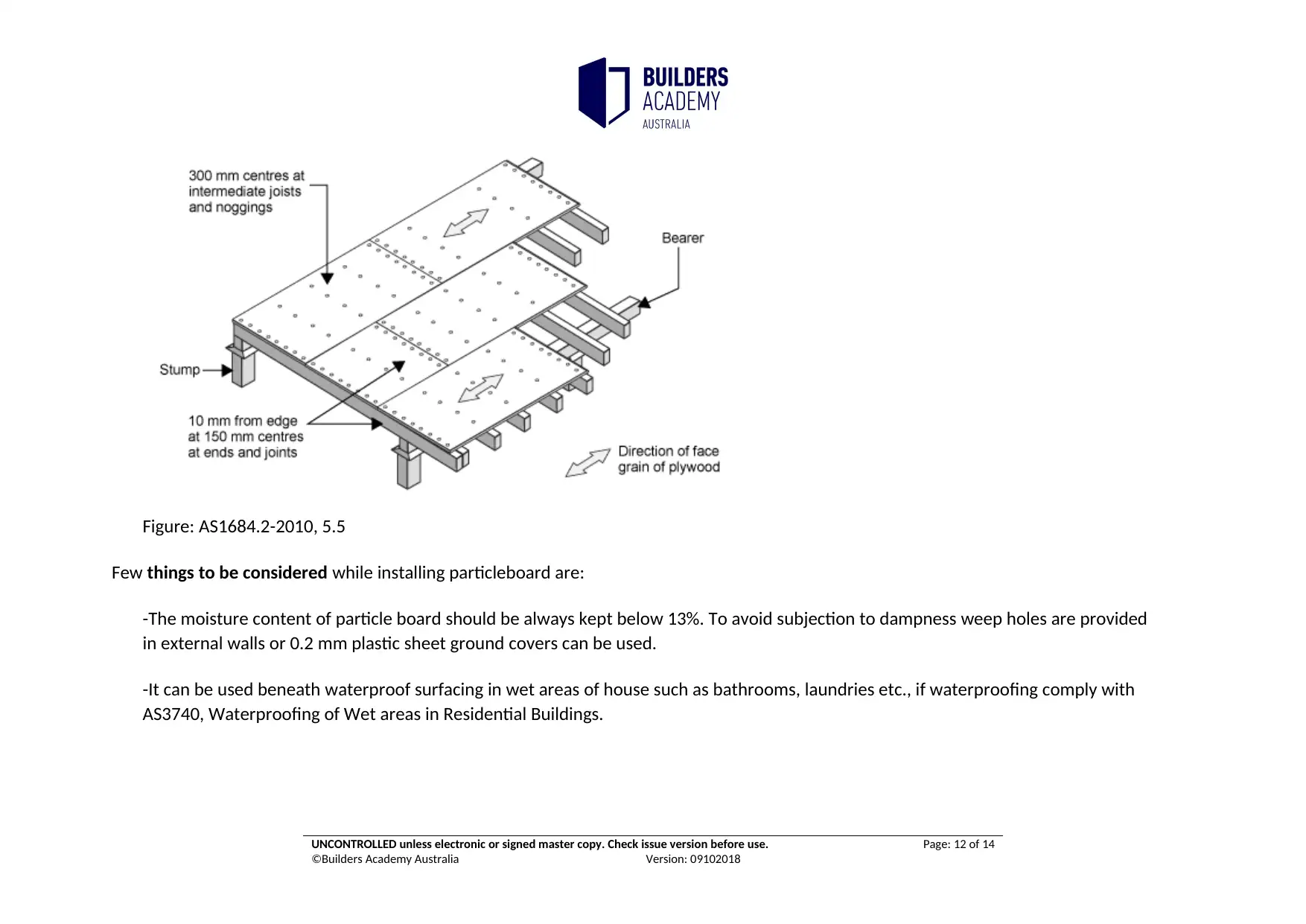
Figure: AS1684.2-2010, 5.5
Few things to be considered while installing particleboard are:
-The moisture content of particle board should be always kept below 13%. To avoid subjection to dampness weep holes are provided
in external walls or 0.2 mm plastic sheet ground covers can be used.
-It can be used beneath waterproof surfacing in wet areas of house such as bathrooms, laundries etc., if waterproofing comply with
AS3740, Waterproofing of Wet areas in Residential Buildings.
UNCONTROLLED unless electronic or signed master copy. Check issue version before use. Page: 12 of 14
©Builders Academy Australia Version: 09102018
Few things to be considered while installing particleboard are:
-The moisture content of particle board should be always kept below 13%. To avoid subjection to dampness weep holes are provided
in external walls or 0.2 mm plastic sheet ground covers can be used.
-It can be used beneath waterproof surfacing in wet areas of house such as bathrooms, laundries etc., if waterproofing comply with
AS3740, Waterproofing of Wet areas in Residential Buildings.
UNCONTROLLED unless electronic or signed master copy. Check issue version before use. Page: 12 of 14
©Builders Academy Australia Version: 09102018
⊘ This is a preview!⊘
Do you want full access?
Subscribe today to unlock all pages.

Trusted by 1+ million students worldwide
1 out of 14
Related Documents
Your All-in-One AI-Powered Toolkit for Academic Success.
+13062052269
info@desklib.com
Available 24*7 on WhatsApp / Email
![[object Object]](/_next/static/media/star-bottom.7253800d.svg)
Unlock your academic potential
Copyright © 2020–2025 A2Z Services. All Rights Reserved. Developed and managed by ZUCOL.




